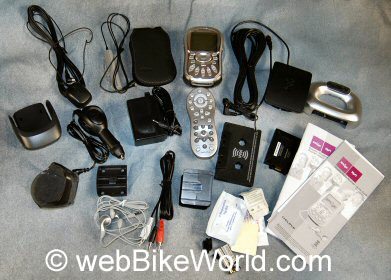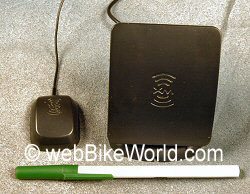MyFi XM Radio Review
Seventy feet is 21.3 meters, or 841.5 inches. That’s how much wire is used to connect the various accessories of the Delphi XM MyFi radio kit together. It’s ironic that a device that most people consider to be wireless comes with 70 feet of the stuff.
We received one of the first MyFi radio production units and I grabbed it right away to give it a workout. I’ve been eyeballing the various iterations of satellite radio for some time, hoping that someone would design the ideal motorcycle radio.
In theory, the MyFi is the perfect solution: it’s pocket-sized, it has a built-in satellite antenna and it receives XM commercial-free radio. What could be better? I’ve tried MP3 players, CD’s and old-fashioned FM radio on my motorcycle with mixed success. The dream of coast-to-coast, non-stop commercial-free jazz and blues was too great to resist.
XM Radio claims that the MyFi radio is “the world’s first XM2go receiver – a personal XM satellite radio”. They sort of beat around the bush, but it’s apparent that the MyFi is being marketed as a device that’s as portable as a Walkman-type CD player, Apple iPod or portable MP3 player. The idea of having commercial-free satellite radio in a pocket-sized unit is very appealing, and I’m sure it will have many takers.
I’ll admit that I was captivated by the advertising. The MyFi held the promise of being the perfect device to slip into a motorcycle tank bag or jacket pocket. Insert the earphones, turn it on and go.
Unfortunately, it’s not quite that simple, as we shall see. The product isn’t as portable as it could be, and the price is, in my opinion, about three times what it should be. But that’s OK, because the motto of us “bleeding edge” early adopters is “we pays our money and we takes our chances” in the quest to be the first one on the block with the new gizmos.
The current price of $349.99 will surely decrease as the device follows the classic new product pricing curve and as the competition heats up (Sirius, where are you?). In the meantime, we can only hope that the antenna wizards will improve their technology also, because that’s probably the most glaring weakness in the overall MyFi package.
What’s In the Box
You’ll definitely be paying a premium for the MyFi version of the XM Radio receiver, at least when compared to some of the other XM receivers, such as the Delphi SkyFi, that can usually be had for less than 80 bucks. The MyFi comes with just about every adapter and gadget in the XM inventory, which possibly accounts for some of the elevated price – and also for the huge amount of wire that’s included in the box.
The package includes:

Where to Buy MyFi XM Radio
Check Reviews & Prices on AmazonSee More: Motorcycle Accessories, Motorcycle Tire, Motorcycle Helmets
MyFi Radio Specifications
The MyFi radio weighs 212 grams, or 7.5 ounces. It measures about 110 mm long (~4-1/4″), 70 mm wide (2-3/4″), and 27 mm thick (7/8″). It fits rather nicely in a man’s size large hand, but it wouldn’t be a bad thing if it was about 25% thinner. The MyFi receives all of the standard XM Radio channels, which can be accessed on the MyFi either by directly entering the channel number on the numeric keypad, by scrolling through the various categories (i.e., Rock, Dance, Latin, World, Classical, News, Weather, etc.) and selecting a channel, or by saving up to 30 favorites ten at a time in the three different banks of pre-sets, A, B and C.
I won’t get into the details of XM Radio’s repertoire of musical offerings. There’s a category for just about every taste, including the “Decades” section with music from the ’40’s, ’50’s, ’60’s and beyond, religious music, talk radio, sports radio, dance, jazz, rock, urban, world radio and more. I quickly found my favorite channels in each category and programmed them into the pre-sets, which is easily done simply by pressing and holding one of the numeric keypad buttons while the channel is playing.
There are many channels that I’ll probably never listen to, but it’s nice to know they exist and hey, who knows when my tastes will change? The only thing that’s missing, and I really hate to admit this, is an “elevator music” channel. Sometimes I just want mindless musical wallpaper in the background, and elevator music can do the trick.
But XM does offer something close: three classical music channels, a “lite jazz” channel and “Audio Visions”, with a playlist similar to the Hearts of Space show that is broadcast on National Public Radio in the U.S. and offers Zen-like “music from outer space”, which is about as peaceful as you can get.
Selecting Channels
The easiest method of tuning in your favorite channel when riding a motorcycle is by using the pre-sets. The tuning wheel on the right side of the radio is just too fussy to use, especially when riding, and it takes too much attention to be safe.
There’s a left/right switch in the middle of the MyFi radio which can be used to scroll through the various music categories. This same switch will adjust the volume when it’s pressed up or down. But once a musical category is selected, the wheel on the side of the radio must be rolled back and forth within the category to select a specific channel.
To tune in to the selected channel, the wheel must be pressed in until it clicks. I wish the channels could be selected using the central switch, perhaps by pushing on the center. Moving one’s hand back and forth between the centrally located switch and the wheel on the right-hand side just isn’t intuitive for me, and it takes a different hand position to get it right, because I don’t have big enough hands to work both switches without relocating my digits. I have trouble getting it right whilst sitting in a chair, much less trying to fuss with it on my motorcycle, so the best option for me is to use the pre-sets.
I also find it hard to push in on the selection wheel without having it jump to a different channel. The wheel isn’t raised far enough away from the surface of the radio either, making it difficult to use with anything other than the tip of my finger. It’s about impossible to work with motorcycle gloves, so my advice is to program the pre-sets and use them when on the bike.
Where to Buy MyFi XM Radio
Check Reviews & Prices on AmazonSee More: Motorcycle Accessories, Motorcycle Tire, Motorcycle Helmets
Reception
The MyFi radio has a built-in XM Radio antenna, but it’s interesting to note that XM (or Delphi) seem to deliberately avoid emphasizing this fact in their product literature. There’s one small note about the built-in antenna in the MyFi radio product specifications on the XM Radio website at the very bottom of the page that’s accessed by clicking on the MyFi radio photo. The note reads “First-ever built-in XM antenna”.

There’s also a short section in the owner’s manual on page 33 under the “Using MyFi On The Go” chapter that suggests keeping the receiver upright for best reception, but it then goes on to explain how to use the wearable antenna and doesn’t suggest that the radio should be used without one.
I gather from all this that Delphi probably understands that the MyFi’s reception without an external antenna leaves something to be desired. Otherwise, you’d think they would be crowing about how wonderful it is to use the radio sans antenna.
I have not been able to get the MyFi radio to maintain a consistent connection to the satellite for more than a few seconds without using either the home or vehicle antenna. The wearable antenna doesn’t seem to do much at all for improving the reception either.
The reason I’m making a fuss about this is that portability is supposed to be what the MyFi is all about. Other than its battery power, there doesn’t seem to be much of an advantage for the MyFi version of the XM Radio receiver over than one of their much less expensive units, like their $79.99 “SkyFi” or $129.99 “Roady 2”, which can be easily adapted for motorcycle use.
Unless I’m missing something, every reference in the owner’s manual to radio reception with the MyFi involves the use of an antenna. This is probably for good reason, because my opinion is that without an external antenna, the radio reception is very poor.

Another problem I have is that Delphi chose to use two different types of antenna connectors, but only the wearable antenna (which doesn’t seem to work for me) can be directly plugged in to the MyFi.
The vehicle and home antennas can only be plugged in to their respective base adapters and not into the MyFi radio itself. Using the base increases the radio’s bulk by about 30% and, I think, greatly affects the portability of the device.
I’m not sure why Delphi decided to use two different antenna adapters, but in my opinion, this is a serious oversight. Since the radio doesn’t seem to work very

well without an external antenna, it would seem to me to make more sense to use a standard adapter that could be plugged directly into the external antenna outlet on the side of the radio without having to use one of the cradles.
The home antenna is designed to be placed near a window (facing the south, preferably) and connected to the MyFi via the home cradle. This works well at home, but it’s certainly not designed for motorcycle use.
The vehicle antenna is much smaller and magnetic, so it can be temporarily attached to a motorcycle fuel tank or other location. It seems to do an excellent job of pulling in the satellite broadcasts. Delphi suggests pointing it towards the south, but I’ve found that as long as the MyFi radio is connected to the antenna and the antenna has a reasonable view of the sky, the music will be clear and uninterrupted, although steep hills or buildings close to the road will definitely affect reception.
I’ve tried placing the vehicle antenna on the bike’s handlebars, fairing and rear cowl, all to good effect. The ideal location to mount the antenna on a motorcycle is a location that is as high and unobstructed as possible.
I’m toying with the idea of cutting the antenna cable and feeding the wires down through one of the vent holes in my helmet. I’m guessing that the top of a helmet will be an ideal location for the antenna, although I’m not sure if it also needs a metal reflector underneath for good reception.
Battery
The MyFi radio also has a feature that’s missing from the other XM radio receivers: an internal battery. The thin Lithium-Ion battery fits into the back of the MyFi unit just like the battery in a cell phone. I get a consistent 3.5 hours of continuous playback, as long as I minimize my use of the radio’s menu, which turns on a background light and uses up some of the battery’s power.
I’m disappointed with the battery life; it would be nice if it lasted about 5 hours. The MyFi can store up to 5 hours (claimed) of music recorded from any of the XM channels, so if the battery also lasted that long, the device would be much more portable. Perhaps someone will develop an after-market battery pack with longer life.
It takes a long 2.5 hours to fully recharge the battery in my unit. I don’t have an external battery-only charger, and I’m not sure if one is available. The MyFi radio must be first connected to either the home or vehicle cradle to be recharged.
It would also be nice if the recharger could be plugged directly into the radio, rather than the base only. This would also make the entire MyFi system would be much more portable and closer to its goal of being a “personal XM satellite radio”.
 Listening to MyFi
Listening to MyFi
The promise of portability is fully realized when using the included ear bud speakers to listen to XM Radio on the MyFi. The speakers that come with the unit are your basic, run-of-the-mill variety that can be found on most any electronic music device.
Several different and higher-quality speakers can be found at many different price points if you’re interested in improving the listening experience.
The speakers that are supplied with the unit are designed to fit most ears, but they don’t fit quite as tight in my ears as they do in others who have tried them. I always wear a helmet liner, and I found that if I insert the speakers in my ears and then put on my silk helmet liner, I can slip a motorcycle helmet on without losing the speakers. I plan on trying some of the combination earplug/speaker units that are available from third-party sources and will report back if I find anything that works better.
The MyFi also includes a built-in FM radio transmitter. A nearby radio can be tuned to one of 12 different frequencies and the MyFi unit can be set to broadcast to it on a matching frequency. Even though we have a full spectrum of commercial radio stations filling the airwaves nearby, so far I’ve been successful in finding a frequency that works and which allows clear reception.
If one of the land-based radio stations is broadcasting on or near the MyFi sending frequency, the reception will be poor with lots of static. I took a 400-mile trip and only had to change frequencies once when traveling through a city with an FM station that interfered with the 88.3 megahertz signal I was using.
The MyFi also comes with a cassette adapter that can be used to connect the MyFi home or vehicle base to an external radio with a cassette player. I don’t have a cassette player in either of my cars, and fewer new cars are being offered with a cassette player, most opting for a CD player instead. A brand-new Sony cassette/CD player that I purchased recently would not accept the adapter either, so the MyFi cassette adapter isn’t a practical device for connecting to external audio sources.
Delphi suggests that if a suitable local frequency for the FM transmitter can’t be found that the owner should purchase and install dedicated converter to connect the MyFi to a radio. This would again limit the portability of the MyFi, because the dedicated converters are a semi-permanent solution. The bottom line is that if there are no open FM frequencies, and if the cassette adapter doesn’t work, the options are limited unless you plan on connecting the MyFi to a home sound system or listening through the ear bud speakers.
Where to Buy MyFi XM Radio
Check Reviews & Prices on AmazonSee More: Motorcycle Accessories, Motorcycle Tire, Motorcycle Helmets

Sound Quality
I’m not an audiophile, but I find the sound quality from the MyFi to be somewhat antiseptic. I’m not sure if it’s caused by the algorithms used to compress and decompress the sound, but it sure seems to me like many of the bits that give recorded music its depth and feel are missing.
I don’t know if it’s the same with the other versions of XM Radio receivers, but the music quality seems reminiscent of the early days of FM radio. It almost sounds to me like monophonic music being played through stereo speakers.
Accessories
The MyFi radio also comes with a patch cable, which can be used to connect the home base to a stereo system that has accessory “line in” input jacks. I don’t own a sound system with this capability, so I can’t

vouch for the performance. Delphi also supplies a belt clip and a couple of vehicle mounting plates that can be attached either to a car’s dashboard or air vent.
The MyFi will probably fit on most motorcycle electronic device holders, such as those used for GPS systems or cell phones. However, the unit is not waterproof. It does fit nicely in the pocket of a jacket or a tank bag, and the MyFi’s internal battery can power the unit while the only external wires are the small magnetic vehicle antenna and the speakers.
Delphi also supplies a standard U.S. style male accessory plug, which can be used in on a motorcycle to power and recharge the unit. So far, I’ve only used the MyFi with its internal battery.
Conclusion
The MyFi radio has lots of potential. It’s really nice to have uninterrupted music for hours on end and virtually coast-to-coast. I find the choices of formats to be plentiful and varied.
The radio’s small size and battery power allows it to be carried in a motorcycle jacket pocket or tank bag, and I have found that as long as the antenna can be suitably located, the radio works very well.
The built-in antenna doesn’t provide the reception that I expected, which is very disappointing, because I didn’t anticipate having to deal with the external antennas and the hassle with their placement. But, I came into this with an open mind, mostly because I realized that the first iteration of this device would probably have some faults. I’m betting that things will improve over time.
In the meantime, if you’re interested in purchasing an XM Radio receiver for mounting on your motorcycle or car, I suggest you check out the other XM Radio options. They offer most of the capability of the MyFi at a fraction of the cost, and offer a more affordable way of getting into satellite radio. XM Radio offers a free three-day trial via an Internet connection, and I recommend that you check it out first before you purchase an XM Radio receiver.
Note: For informational use only. All material and photographs are Copyright © webWorld International, LLC – 2000-2011. All rights reserved. See the webBikeWorld® Site Info page. NOTE: Product specifications, features and details may change or differ from our descriptions. Always check before purchasing. Read the Terms and Conditions!
|
wBW MyFi Satellite Radio – Delphi XM MyFi Radio Review |
|
| Available From: XM Radio | Suggested Retail Price: $349.99. Service $9.99/month. |
| Colors: Chrome/Silver | Made in: Malaysia |
| Summary: Wide variety of music formats should suit many tastes. The radio is not as portable as I thought it would be, but it works well for motorcycle use. Needs separate base adapter for external antenna and for recharging, which add to the bulk of the unit. Internal antenna offers poor performance compared to the external antennas. Radio works well if the external antenna is used. Battery only lasts 3.5 hours and takes 2.5 hours to recharge. | |
| More: Home | Review Index | |



 Listening to MyFi
Listening to MyFi
Note that XM broadcasts in Monaural.